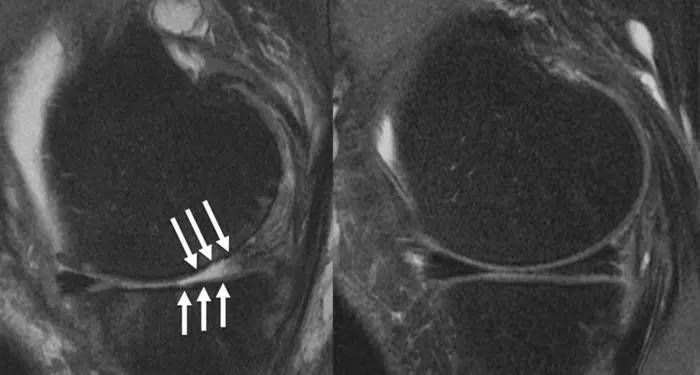Radiological Society of North America, CHICAGO
Highlights
|
Stronger quadriceps muscles , relative to the hamstrings , may reduce the risk of total knee replacement, according to research presented at the annual meeting of the Radiological Society of North America (RSNA). The researchers said the findings could inform strength training programs for people with advanced knee arthritis.
Advanced knee osteoarthritis is a major cause of pain and disability worldwide. In the U.S. alone, 14 million adults suffer from symptomatic knee osteoarthritis, and more than half of those diagnosed are expected to eventually undergo total knee replacement surgery.

Image : Knee joint of a patient showing (A) severe cartilage defects and (B) intact knee joint.
While it is generally understood that stronger muscle groups are associated with a lower rate of total knee replacement, their relative importance is not well established. Of particular interest is the relationship between the extensors and the hamstrings, the two most important muscle groups of the knee.
The extensors , the muscles of the front of the thigh, commonly called the quadriceps , are the strongest muscle group in the body and have an essential influence on walking, other activities, and biomechanics. The muscles surrounding the back of the thigh, known as the hamstrings , are responsible for hip extension and knee flexion, making them equally essential for physical activity.
"The two muscle groups act as opposing forces, and the balance between them allows for a wide range of activities while protecting the knee joint," said the study’s lead author, Upasana Upadhyay Bharadwaj, MD, of the University of California, San Francisco (UCSF). "An imbalance, in addition to other factors, causes a change in biomechanics that results in the progression of osteoarthritis."
Dr. Upadhyay Bharadwaj and colleagues assessed thigh muscle volume in 134 participants in the Osteoarthritis Initiative, a national study sponsored by the National Institutes of Health. They compared 67 patients who had a single-knee total knee replacement with 67 control participants who had not had a knee replacement. Cases and controls were matched according to variables such as age and sex.
The investigators obtained a 3T MRI of the thigh at the time of surgery. They also evaluated MRI findings two and four years before surgery. They used a pre-trained deep learning model to segment and calculate thigh muscle volumes, measurements that are tedious to calculate manually.
When comparing patients who underwent total knee replacement with the control group, a higher quadriceps to hamstring volume ratio was significantly associated with lower odds of total knee replacement. Greater volume of the hamstrings and gracilis, a long, thin muscle on the inner thigh, was also linked to lower odds of total knee replacement.
"Our study shows that, in addition to individually strong muscles, larger extensor muscle groups, relative to hamstring muscle groups, are significantly associated with lower odds of total knee replacement surgery in two to four years," said the Dr. Upadhyay Bharadwaj.
The study findings have implications for both the interpretation of imaging examinations and clinical management. The results suggest that training programs that strengthen the quadriceps relative to the hamstrings may be beneficial.
"Although we hypothesize that overall muscle volume is important as a surrogate marker of muscle strength, the relationship, and therefore balance, between the extensor and hamstring muscles may be more important and significantly associated with lower odds of total muscle replacement. knee," said Dr. Upadhyay Bharadwaj. saying.
Although the study focused on people with arthritis, the findings may also help inform strength training for a broader segment of the population.
"While these results are essential for targeted therapy in a population at risk for osteoarthritis, even the general public can benefit from our results by preemptively incorporating appropriate strengthening exercises," said Dr. Upadhyay Bharadwaj.
Co-authors are John A. Lynch, Ph.D., Gabby B. Joseph, Ph.D. and Thomas M. Link, M.D., Ph.D.
















